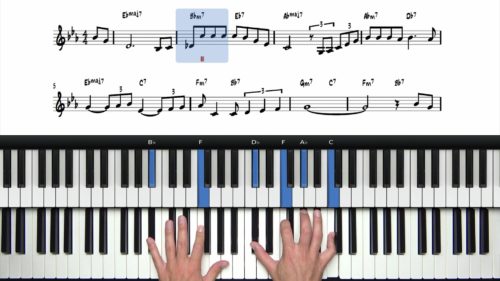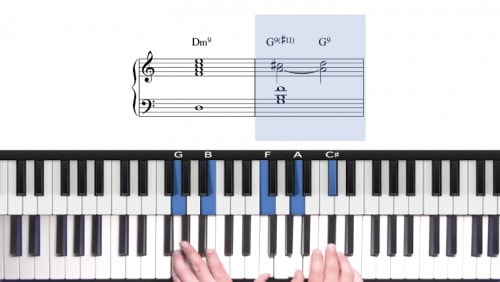Targeting Altered Tensions
In this lesson we identify and target individual alterations over dominant chords to tastefully fill in the space when the melody is static.
4 Possible Alterations
It’s important to remember that there are only 4 possible alterations for a dominant chord. These are the b9, the #9, the #11, and the #5 (the #5 can also be referred to as the b13).
Whilst the alterations might be difficult to visualise at first, with practice we can visualise these tones clearly in relation to the underlying harmony and include them in our voicings, fills, and improvisations.
Altered Tension Workout
In this lesson we explore a 3-step process that we can follow to identify the altered tensions that work well over any given dominant chord. The 3-step process is as follows:
-
- When we find a dominant chord we play a dominant shell voicing in our left hand and play the altered mode in our right hand. This helps us to visualise the altered notes in relation to the dominant chord.
-
- We then work through each alteration individually to identify if the altered tension complements the harmony, or clashes with the harmony. If the alteration is a half step away from the melody note, this will often result in a clash. There is usually more than one alteration that we can play for any given dominant chord, and we can also combine alterations to create more complex altered dominant sounds.
-
- After completing the 2 steps above, we then make note of the altered tensions that we like and that complement the harmony and then we target these alterations using chromatic and arpeggio-based approach patterns. This is a useful technique to fill tastefully fill in the space and add interesting colours and tensions to our solo piano arrangements.
Lesson Downloads
-
Targeting Single Alterations File Type: pdf
Practice Tips
-
There are only 4 alterations for each dominant chord which are the b9, the #9, the #11, and the #5 (the #5 can also be referred to as the b13).
-
For each dominant chord in the tune, identify and play the altered mode which contains the following scale degrees: R-b9-#9-3-#11-#5-b7.
-
The next step is to systematically work through each 4 alterations and add these into the chord voicing. Some will sound great, and others will clash.
-
Make note of the ones that sounds pleasing and then target these using chromatic approach patterns to tastefully fill in the space over dominant chords when the melody is static.









Good news/ bad news. The bad news was that I got my first bout of COVID and was home from work, rather sick, for these past two weeks. The good news is that I immersed myself in this module – stride, fills, octave playing, U/S’s, targeted tension notes, etc. for several hours a day. It was a great balm and a perfect time to really dive into the many brilliant things you impart so skillfully. The song track to my COVID movie will forever be The Nearness of You. Thanks for this gift
Hi Marc,
Sorry to hear on the covid and wishing you a swift recovery!
I’m glad you are enjoying these lessons. It’s important to try to apply these concepts to other tunes that you are playing. For example “Misty” and countless other tunes contain very similar harmony such as the repeating 3625 progressions on the 2nd line of the A section. Whenever you see this progression, these melodic fills and embellishments will work great.
Also once you practice these sounds you will build an aural appreciation for UST runs, specific alterations etc… and it becomes easier to pick out and dissect fills from any recordings you are listening to.
Have fun practicing this stuff and let me know if you have any questions.
Talk soon,
Hayden
It occurred to me just a moment ago the irony of studying such a song title during quarantine
Haha yes ironic indeed :–)
Get well soon!